
Two artists featured in The Power of Intention: Reinventing the (Prayer) Wheel put commitment and belief at the heart of their practices.
We may not think that intentions have power, but in Buddhist culture they define the quality of any action. Commitment and belief are key mental attitudes needed to harness the power of intentions, embodied quite literally in Tibetan prayer wheels. The clockwise rotation of such wheels is believed to propel the thousands of written prayers and mantras contained within these ritual objects into the world.
The works of Youdhi Maharjan and Monika Bravo are as different as the artists’ personalities yet exemplify these ideas, and the two share strong connections in their approaches to creativity and the meaning of art. Together with the other artists featured in the exhibition The Power of Intention: Reinventing the (Prayer) Wheel, which brings together select examples of traditional and contemporary art, they take the Tibetan prayer wheel on a conceptual spin.
Maharjan creates intricate collages out of reclaimed book pages through a meticulous process that demonstrates incredible commitment, a state of being that is central to the Buddhist understanding of intention and practice. Although he is not a Buddhist, his familiarity with the philosophical, literary, and intellectual wealth of Indic cultural traditions shines through in his work and conversations.
Bravo explores questions of human perception and the decoding of information through a range of media. She draws from her creative experiences in fields from fashion design to photography, as well as from her practice in her native Bogotá and in the United States. Bravo actively works with and manifests emotional states in her work, specifically the powerful notion of belief, which is essential to empowering intention.
Both artists find joy in creating art, working with text, and transforming it into something new, and they find this process empowering. They believe that text can restrict us by delivering its meaning too easily and taking over the reader’s mind. The artists’ creative manipulation of text allows new meanings to be revealed. Each person who sees the text encounters it anew and makes it their own. Even though their art forms vary dramatically, Maharjan and Bravo both “accidentally” discovered the books that inform their works in the exhibition, attracted by their titles, but they employed those texts with purpose and intention.
Youdhi Maharjan and the Power of Commitment
Elena Pakhoutova: Your work is a perfect example of the power of commitment. It takes determination and patience to work each page in a very precise manner. How does it help you realize the finished piece? Do you have an image of what the piece will look like?
Youdhi Maharjan: The end result is not determined but the process is. I decide in the beginning what to do with the book, what steps or formula to use, whether to cut all around the letter O and connect the O
Os with straight lines or organic lines. It is based on the title of the book which inspires the visual work, and the work interprets and gives a new meaning to the title. The process is very monotonous, doing the same thing over and over. In Turning the Wheel (2018), I pierced the book pages with needles in repeating circles, cut individual letters, and then glued them back in Committed to Becoming (2018). There are surprising elements in this process. It is labor intensive; it hurts my fingers, eyes, and back, and I have to prepare mentally. I get joy from doing this, even if it seems mundane. I am making something by hand, myself.
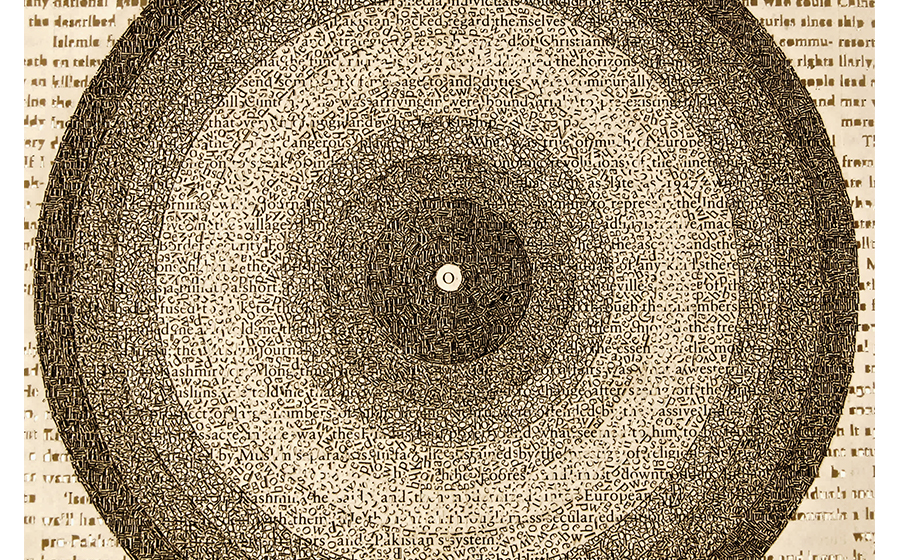
Are you saying it is an empowering feeling?
Yes, like finding the meaning of your existence. We live today in a technological age. Everything is faster. We save so much time, and what we do with that time? Do we spend it watching Netflix or doing or making something? To me the process is important. I can do the same thing using technology and get the “product” done in a few minutes. My investment, my relationship with the materials and the process””touching the book physically, engaging with the process, cutting one letter at a time””gives me the encouragement, the power I need to commit to do this again and again.
The process itself is what gives you the power to keep doing it?
Yes, the more I work the more I get into it.
How would you define power?
For example, the power of prayer is not about the prayer but the power of intent. Why you pray is more important than the actual prayer. In the Ramayana story, monkeys write the name of Rama on every stone. The stones float in the ocean, and that’s how the bridge to Sri Lanka was built. It’s not by writing Rama’s name on these stones that they don’t sink but by the power of faith and aspiration. I think some people pray to get something out of it, but for myself, I produce works because I find meaning in the production of these works. In a similar way, rabbis, priests, or monks find happiness in praying. When you take your focus out of the end product and do anything you find joy in doing, the process itself is the end in itself and is not the means to get something.
This is different from how people generally think””you do something to get something and want immediate satisfaction. Your work is the opposite of that.
Very opposite. I slow down time, so it is an opportunity to slow down from the materialistic life. It allows me to reflect on different questions we don’t usually ask on a daily basis.
Such as?
Such as the meaning of happiness, existence and the purpose of life, relationships, love, god, spirituality, inner world versus outer world. When you have an intent and no expectations, then you are fully committed to action. When you are focused on the result of your action, you are distracted. It’s like going from point A to point B and only focusing on getting there, whether you fly, drive, or walk. But when you are focused on driving or walking, you actually enjoy whatever you do rather than missing everything that happens.
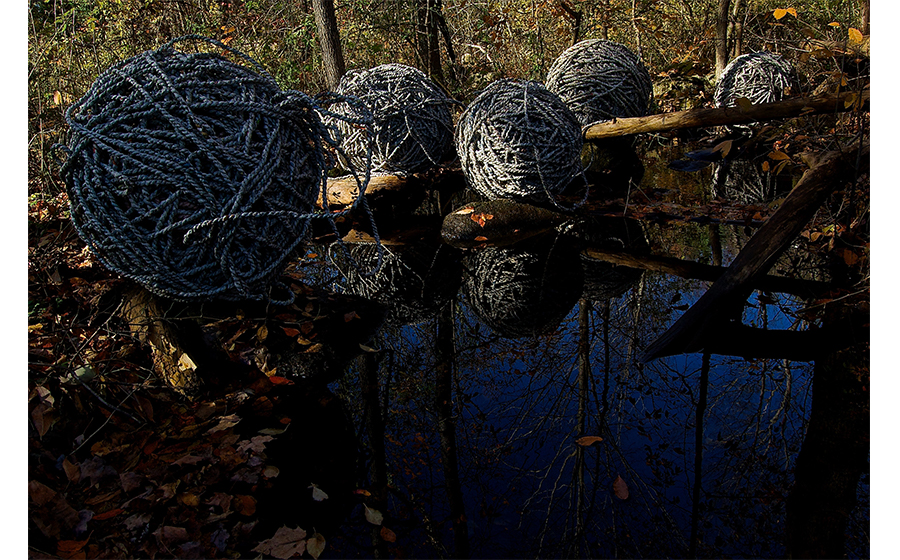
Can you talk about the most time-consuming piece you worked on?
It is the piece I worked on using newspapers as material. I handwove found newspapers into very long pieces of rope. Hypothetically, these do not have a beginning and end. I will be making them until my body can’t make them. It is nine miles long now.
When did you start?
I started in 2010 and worked on it until 2013. It grew too big for me to store and to transport for shows, but I am still working on it. I roll the rope into balls four to five feet in diameter. I showed them last year in San Francisco. It is taking something already useless and making something absolutely useless out of it. Rope should have a function, but it’s not strong enough to be used as a rope. When you focus on the functional ability of an object, you forget and ignore its materiality, its aesthetics, its essence. But when you take the function out of the equation you are committing to the process of making it, and the viewers are also committing to the essence and materiality of the object rather than its function. I was trying to make something just for the sake of existence without having any meaning or purpose””a purposeless object.
But why?
That’s the question I ask. Do we have to have meaning as human beings? Do our lives have to have meaning? Is there a certain way to live a meaningful life? If someone is a doctor and saves lives, is his life more meaningful than mine as an artist whose contribution to society is different?
You are saying that we have to figure out our purpose ourselves and it’s a process. Yet this rope or paper yarn also has a purpose: it’s an art object.
Yes, but the purpose of an art object itself is questioned””its meaning, its service to society””as with any abstract painting or sculpture.
Why are you committed to continue working on this project?
It is a relationship. I am engaged in the process and this gives me meaning, and my engagement with the object gives meaning and purpose to this useless newspaper.
So you create meaning through working and when people look at the work they discover meaning themselves?
Always.
Your artistic practice is repetitive work. It’s like turning the prayer wheel””it does not do anything but the idea is that something is happening.
Yes, like turning the prayer wheel, something is happening, an active engagement in the process, but it is not mindless, thoughtless engagement.
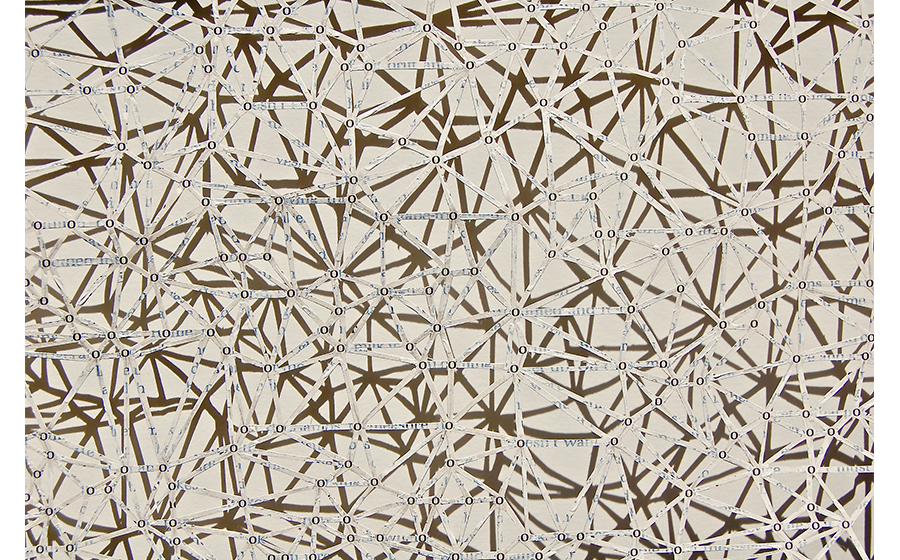
When I looked at the Power of Thought (2018) and read the title, I immediately thought of neurons in a brain.
Yes, interconnectedness. This work is also about the fragility of our faith and our intentions. We can very easily become distracted, tempted to do something else. Having a wish does not do much; you have to have a will as well.
How do you decide what kind of connections to make within a page?
In this work, all the Os are connected to each other with triangular shapes.
What do you use as the connecting tissue?
It’s the same book pages, and the text is whited out. In addition to fragility, there is also strength. Even though it is fragile, it is also strong through connectedness. Os are also selected because of their reference to shunyata, emptiness, which could mean nothingness but also means that everything is empty and nothing is empty at the same time.
What is the meaning of Committed to Becoming (2018)?
At the center is O, again shunyata, and all the text is cut out individually and glued around the O, from very dark to lighter density and then again darker, like a pulse. It’s not static but a ripple. A high ripple, low ripple, and high again.
Like how dropping a stone in a pond produces ripples in the water?
Yes, like that.
You are trying to achieve it through the density of the collage?
Yes. It becomes darker where more letters are glued, and lighter where there are less. It refers to the highs and lows of the process of becoming and hints at the continuity of that process. It does not end, never gives up, and starts at the center from nothing. Out of nothing through the power of intention you commit to make something or become something. Even if you don’t succeed, you keep trying.
How did you make Turning the Wheel (2018)?
Very simple process: leave all the Os, whiteout the rest of the text, and draw concentric circles outside of those Os, piercing with a needle””one hole at a time””using a ruler with holes punctured by a needle.
How does this relate to the idea of turning a wheel?
It relates to the act of making holes repeatedly and the continuity aspect of the work. The circles grow bigger and bigger and keep expanding.
Turning also means you have to go round and round, right?
Yes, you turn the prayer wheel. You also go around a stupa, and the mantra inside a prayer wheel is rolled in a cylinder. The idea of circle is very prominent in Buddhism and Hinduism. The idea of birth and rebirth, never ending.
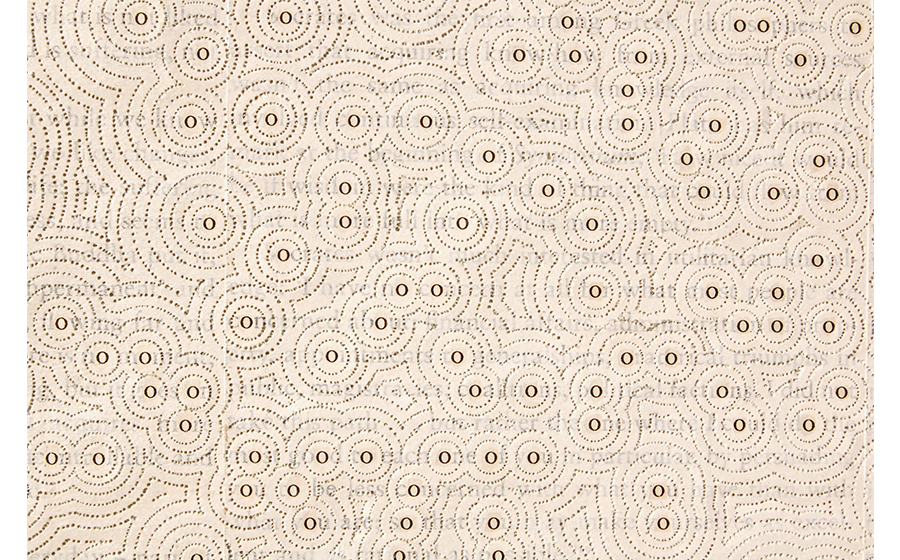
How did you decide to do this kind of work? What was the impetus for you?
I was into creative writing during my undergrad years and then took classes on existentialism and read Samuel Beckett’s Waiting for Gadot, a two-act play where two characters wait for someone named Gadot who never comes. They wait and wait and Gadot never comes. The way I read the book is: even if there were a hundred acts, they would do the same thing, and you will never know whether they meet Gadot, why are they waiting, or what is the purpose of their waiting. Nothing is revealed to you. The idea that a story must have a beginning, middle, and end is questioned. I moved away from writing and worked more toward this idea of continuity. Even though you get little from the story, you like reading the book, you relate to the characters, you enjoy the process.
Why did you move away from writing?
Because I was writing stories with a beginning, middle, and end. I wanted to tell the kind of stories where there is no narrative, no end game, no epilogue, no resolution. The readers or viewers would find their own resolutions.
But there is still a story.
There is always a story. There is always a beginning, middle, and end.
Something that begins has to end.
Yes, that’s the nature of things. That is why the idea of foreverness or infinity interests me. We say forever but there is no such thing as forever.
Well, it’s a word.
It’s a word, a notion to which anyone can ascribe anything. No one has experienced it. We don’t know what it is.
Is it more interesting for you to work with these ideas in material, tangible forms rather than writing?
I have always wanted to mix writing and visual art together.
That’s why you work with text?
That’s why I took creative writing classes in college.
Do you still write?
I don’t particularly. Sometimes, it’s experimental writing, like I was working on a series where I’d take a word and replace it with a synonym, then with a synonym of that word, and then keep replacing it with synonyms until I got the antonym of the first word. So love becomes hate through the process of replacing the original word with words that are supposed to mean the same thing.
What are you working on for future projects?
I am doing more sculptural works now. It’s the same process””cutting and gluing””but displayed as a sculptural work. I also use other techniques, like scraping and burning with incense, but still very repetitive actions.
Why have you decided to do more sculptural work?
To try something new. Some titles don’t want to be flat, and I think it adds more layers to an idea of meaning. In sculptural pieces, the shadows and the work itself changes once you move from one point to another. In flat pieces, you can still read something through the cut outs, even though it slows the process of reading. But in sculptural pieces, the process of information gathering becomes a journey; it’s not easily as accessible as just reading a sentence. That is the main idea of my works: the act of getting answers to your questions should not be easy. You have to work for it.
Monika Bravo and the Power of Belief
Elena Pakhoutova: What can you tell me about your artistic practice and process?
Monika Bravo: It depends on the project. Some things come to me as images, as concepts. It’s how I process my own reality; I get insights and then I have to materialize them. I have been practicing meditation for a long time, so I can observe my emotion and transform it into something else. I have a method of doing this””a lot of observation. Landscape of Belief (2012) came from a moment when I was not feeling very good. At the time I had an idea that I had to do certain things to achieve something, but it was not happening, and I was taking this personally, thinking my work and I were not good enough. I was really suffering. I was supposed to be in a gallery exhibition, but they told me, “Don’t take it personally, but we didn’t have time to put your work in the show.” I felt devastated. I was trying to be brave that day, but I wasn’t. At the time Marina Abramovic was not that famous. At the opening dinner, this woman I sort of recognized sat next to me, and we started talking. I didn’t tell her anything directly, but she was very perceptive and said, “Don’t you ever give your power away to anybody. You have to go inward and find your own power. You are very powerful, but you don’t know it yet.” So I took these feelings and decided to do something with them. I took the title of the show, Textual Landscape, and I said to myself, I’m going to create the most amazing piece. I closed my eyes and started imagining the piece””it was a landscape but it was also a text, maybe a cityscape.
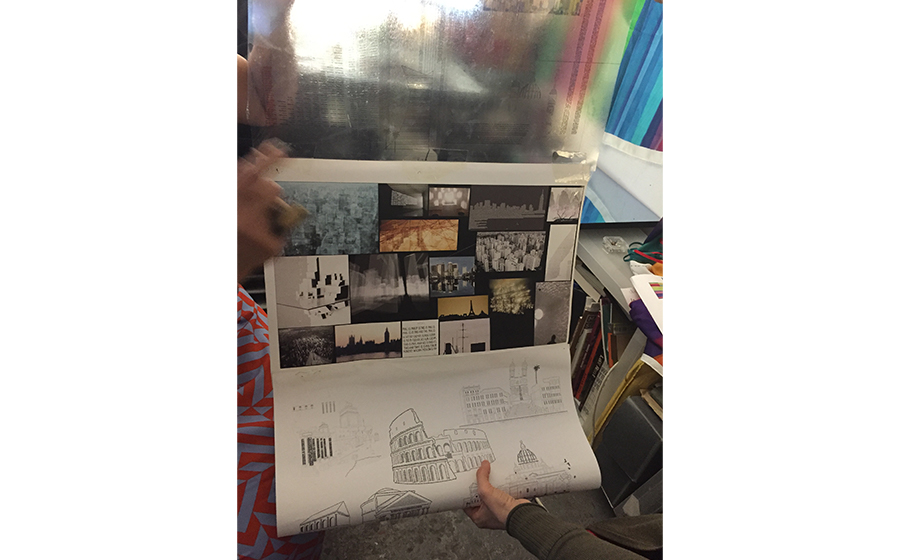
I started imagining a building, making drawings, taking images from Google that fit my feeling””lightness, light, transparency, no color””which is unusual because my work is very colorful. I didn’t really know how I would do this, and I asked a friend to help me hire an assistant for animation. It’s always about what I feel when perceiving my reality. This is the process. This work took three years to make. I had an assistant each year.
My first idea was to make this on the wall, but I needed to express a sense of freedom and wanted to put myself away from the wall and into the center. I also felt that I was being very vulnerable, and working with glass is being vulnerable. A lot of materials I use are about manifestation of the body. Very often when people think of the spiritual they forget about the body, or they are so engrossed in their bodies they don’t understand that the spirit is there. So understanding that the body is the vehicle of our spirit has to be represented. That’s why Landscape of Belief is glass and in the center, because there is a possibility it will break, a certainty that we are going to die but not knowing when. This tension I like and use in my work a lot. I didn’t know what text I’d use. I knew it was about belief.
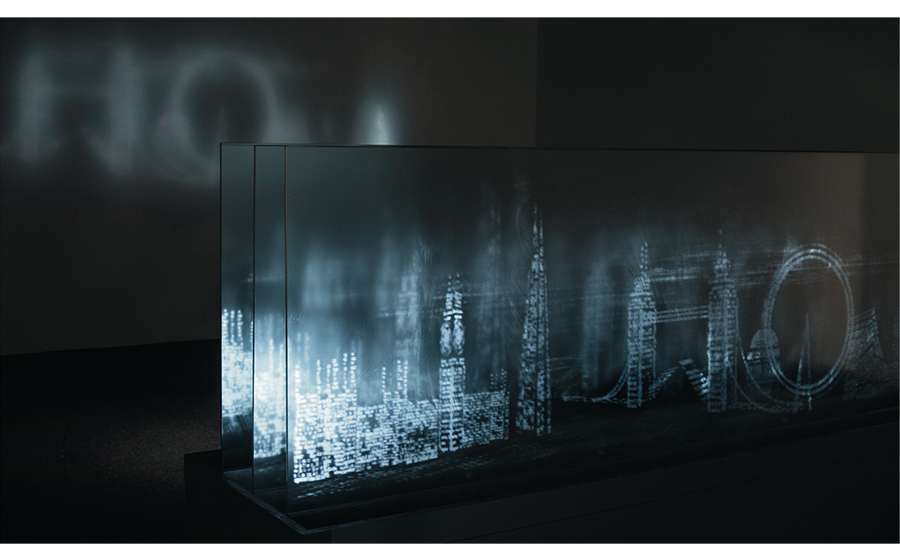
Why belief?
It’s very important. I was feeling that the work was what I was believing or not believing myself. I was giving the power to other people to believe that I am capable or not capable. When we assign values to ideas and we practice them, they become beliefs embedded as belief systems. You believe an idea, you practice it a lot, and it becomes your reality. I believe that we are creating every moment. I wanted to do a project that went very deep into the fact that we are creating these realities and we are all responsible for them. People tend to blame everything on the other and always talk about society outside of themselves, but they don’t acknowledge that every situation, every idea, every action is connected to something. What you do every day is changing reality. This is the only thing that I have power over.
I didn’t want the text to be dogmatic. When you talk about a book, it already has an identity, like cities too. The text came after meditation. I was working with numbers until then and needed a text. One day, about a year and half into the project, I heard about Italo Calvino’s Invisible Cities, and I went online and bought it. I opened it, and this was the book. It was like downloading something into my head.
How does Landscape of Belief relate to the exhibition The Power of Intention: Reinventing the (Prayer) Wheel?
There are seven animations of cities that continuously appear, and between them is a little lapse of two seconds that is most important to me. It’s this moment where there is nothing. It refers to the moment when your mind is open and you allow anything to come through. Things like architecture or literature restrict you, draw you along. You are not yourself really; they define you, and you lose yourself in there, and when you lose yourself, you are not aware and are reactive. Those seconds when there is nothing, the moment when we can still our mind and we are open, that’s when we become aware, and when we are aware, we can make an intention that is so strong it actually happens. It becomes magical because it is so strong.
Lately I have been meditating on faith, but not on faith like they teach you, like a prayer in the Catholic tradition, which is quite heavy. For me, I do not use the word prayer because of my Catholic upbringing. One day I’ll come to terms with it, but it is more like being one with myself, or encountering that open space.
Like an aspiration?
Yes. It’s an open space. Before I meditate I always have an intention. I do my prayers, my mantras. I do it all the time, because it has worked for me since I was little. I don’t question it when it becomes magical, because I’ve already put a lot of value in it from the very beginning. So yes, it has a lot to do with it, but I think when I made this piece, I was not necessarily thinking that what I was doing was about practice or meditation. But it is very much embedded in my practice, so it’s not disconnected from that. At the time, I was not so much aware of definition or not definition, because I was working with some other things. Now I am more aware of it””not being too defined by things””and I have taken other practices like astrology, human design, I Ching, and other ways of decoding information from the mind.
I wrote a little text and was thinking about myself “artist,” “poet.” People always try to define you, and this is a big problem, because everybody is so separated. Last year I was allowing myself to make things that are not so important to be part of the whole and to stop defining myself. Everything is part of it. I do readings in the morning; it’s an integral part of my mind to connect to other people even if I don’t know them, because I connect emotionally through the soul and decode what they are doing. It is so inspiring, so it’s like creating art without being artistic. Then I go to the studio and have the same intention, so it’s a different kind of experience, or experience of the same kind of joy, because there is a lot of joy when I am working. There is a lot of bliss when I am working. Right now, I am integrating. I like that word a lot. Integration comes from Latin, and it means to be intact, to be wholesome. Then you don’t need to define, as everything is there; it’s integrated.
What are your future projects?
I am integrating all the stuff I love. I’ve been doing some textiles, looking where this form is going to go what does it mean. I did fashion design before I became an artist, and I was always fascinated by fabrics; I have a collection of fabrics from all over. Our ancestors were working with fabrics, and I love the word fabric. We always talk about the fabric of reality; it’s one of the closest things to talk about materiality, and I am very interested in materiality, because this is the only way I am going to be able to transcend my soul through this material body. I cannot run away to a cave and become immortal, but I can be here and dealing with material things: hunger, sleeping, eating.
I am making some kimonos with an idea of how objects change value depending on what value you give them in the moment. Kimonos represent a lot of things in Japan, not only socially but politically. It was very easy to make; with the kimono””which means things to wear””with five meters of fabric you could define whether you are married or not and how old you are, depending on the size of the sleeve. When Japan became more Westernized, they put kimonos on the wall as objects of history and decoration, and it changed value. Objects change in time.
I am interested in how we give value to something. It’s kind of like intention, how we give value to something and then meaning becomes the value that you give. The word value is becoming more important to me, because in astrology, for example, value is the relationship you have with yourself. If you have value in a relationship with yourself then you can have self-love and self-worth and therefore you can become powerful, meaning you know how to take care of yourself. You know what you need, what is essential to yourself, so when you sit down with someone you have a relationship with (not necessarily a love relationship) and you have value, you have leverage, and you attract the same value, which is equivalent. You can have a good relationship with any person. So the value you give to yourself you receive from the other.
At the Rubin in 2019 we are focusing on the theme of power and the idea that power is not given to you but is inside you.
In astrology the archetype for power is opposed by self-value, self-worth, self-love. In order to be very powerful you have to know what you know and what you need. I realized that when you have a position of power but you come from the position of lacking something, you will always be abusive, because you fulfilled the need to get there, no matter what it is. You have it now, but you become bored because you don’t have to strive for it anymore, and you become abusive. This is the energy that becomes its opposite. This is not real power.
See works by Monika Bravo and Youdhi Maharjan in the exhibition The Power of Intention: Reinventing the (Prayer) Wheel at the Rubin Museum from March 1-October 14, 2019.
About the Contributors
Monika Bravo is a multidisciplinary artist born in Bogotá, Colombia, who currently lives in New York City. She studied fashion design in Rome and Paris and photography in London. One of her most well-known works is September 10, 2001, Uno Nunca Muere La Vispera (2001), dedicated to artist Michael Richards who died in the 9/11 attacks. Bravo represented the Vatican City-State in the 56th Venice Biennale, with the commissioned installation ARCHE-TYPES: The sound of the word is beyond sense (2015).
Youdhi Maharjan is a visual artist from Nepal who currently resides in New Hampshire. He works with repurposed texts to create a new language, exploring the materiality of text and reasserting its thingness. Through his work, he tackles complex dichotomies, such as spirituality and nothingness, science and art, mass production and attention to detail, journey and final destination. He holds a BA in creative writing from New England College and an MFA in art history from the University of Idaho.
Elena Pakhoutova is a curator of Himalayan art at the Rubin Museum of Art and holds a PhD in Asian art history from the University of Virginia. She has curated several exhibitions at the Rubin, most recently The Second Buddha: Master of Time (2018) and The Power of Intentions: Reinventing the (Prayer) Wheel (2019).


